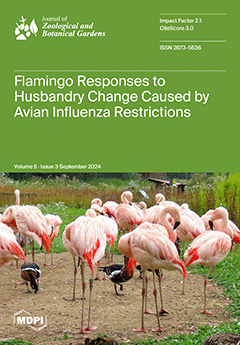Open AccessArticle
Coprological Survey of Helminths in Reindeer (Rangifer tarandus) in 50 Selected Zoos and Menageries in Russia
by
Olga A. Loginova, Svetlana V. Akulova, Dmitry N. Egorov, Natalia S. Egorova, Sergei E. Spiridonov, Iuliia K. Plotnikova, Larisa M. Belova, Yuriy E. Kuznetsov, Daria I. Chuprak, Anna A. Krutikova, Iuliia V. Vasilkova, Diana A. Gelashvili, Yuri A. Shchepanovsky, Ivan A. Mizin, Danila V. Panchenko, Mikhail G. Bondar and Taras P. Sipko
Viewed by 899
Abstract
Zoo conditions are unique for reindeer, since domestic reindeer are not kept in captive facilities like cattle. In the zoo, reindeer are usually surrounded by many different animals that they would never encounter naturally. Thus, they might be infected with new helminths. Numerous
[...] Read more.
Zoo conditions are unique for reindeer, since domestic reindeer are not kept in captive facilities like cattle. In the zoo, reindeer are usually surrounded by many different animals that they would never encounter naturally. Thus, they might be infected with new helminths. Numerous petting zoos raise concerns about the safety of tactile interactions for human visitors. Our study is the first large-scale one. Qualitative and quantitative fecal analyses were carried out for 233 reindeer distributed over 50 Russian zoos according to the National Standard of the Russian Federation (GOST R 54627-2011)
Ruminant animals—Methods of Laboratory Helminthological Diagnostics. Where possible, DNA analyses of helminths were performed targeting internal transcribed spacer region. As a result,
F. hepatica,
Paramphistomum sp.,
Moniezia sp. (including
M. expansa), gastrointestinal strongylids (including
Nematodirus spp.),
Dictyocaulus sp.,
E. rangiferi,
Trichuris sp., and
Capillaria sp. were found in 106 (45%) zoo reindeer. All these helminths were previously reported in reindeer and pose no direct danger for humans. The intensity of invasions was mostly low. Fecal examination might be considered as an indirect method for mange diagnostics, as
Chorioptes and
Demodex mites were found in reindeer fecal samples. The latter may represent a novel species of mite specific for reindeer.
Full article
►▼
Show Figures





